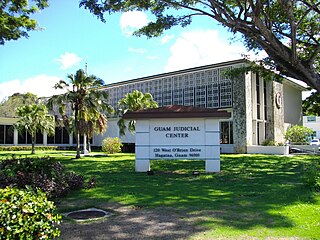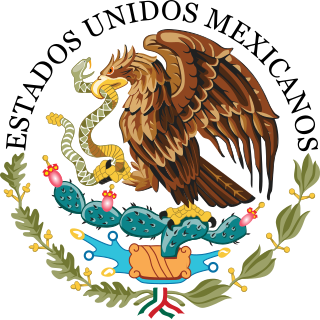
The United States courts of appeals are the intermediate appellate courts of the United States federal judiciary. The courts of appeals are divided into 11 numbered circuits that cover geographic areas of the United States and hear appeals from the U.S. district courts within their borders, the District of Columbia Circuit, which covers only Washington, D.C., and the Federal Circuit, which hears appeals from federal courts across the United States in cases involving certain specialized areas of law. The courts of appeals also hear appeals from some administrative agency decisions and rulemaking, with by far the largest share of these cases heard by the D.C. Circuit. Appeals from decisions of the courts of appeals can be taken to the U.S. Supreme Court.
Myers v. United States, 272 U.S. 52 (1926), was a United States Supreme Court decision ruling that the President has the exclusive power to remove executive branch officials, and does not need the approval of the Senate or any other legislative body. It was distinguished in 1935 by Humphrey's Executor v. United States. However, in Seila Law LLC v. Consumer Financial Protection Bureau (2020), the Supreme Court interpreted Myers as establishing that the President generally has unencumbered removal power. Myers was the first Supreme Court case to address the president's removal powers.

The primary and fundamental statement of laws in the Russian Federation is the Constitution of the Russian Federation. Statutes, like the Russian Civil Code and the Russian Criminal Code, are the predominant legal source of Russian law.

Loyola University Chicago School of Law is the law school of Loyola University Chicago, in Illinois. Established in 1909, by the Society of Jesus, the Roman Catholic order of the Jesuits, the School of Law is located in downtown Chicago. Loyola University Chicago School of Law offers degrees and combined degree programs, including the Doctor of Juridical Science (S.J.D.).

The Chief Justice of Pakistan is head of the court system of Pakistan and the chief judge of the Supreme Court of Pakistan. The officeholder is the senior most of 17 senior justices of the Supreme Court of Pakistan.

The Supreme Court of Puerto Rico is the highest court of Puerto Rico, having judicial authority to interpret and decide questions of Puerto Rican law. The Court is analogous to one of the state supreme courts of the states of the United States and is the highest state court and the court of last resort in Puerto Rico. Article V of the Constitution of Puerto Rico vests the judicial power in the Supreme Court, which by nature forms the judicial branch of the government of Puerto Rico. The Supreme Court holds its sessions in San Juan.

James Andrew Wynn is an American jurist. He serves as a United States circuit judge of the United States Court of Appeals for the Fourth Circuit and formerly served on both the North Carolina Court of Appeals and the North Carolina Supreme Court.

The Supreme Court of Guam is the highest judicial body of the United States territory of Guam. The Court hears all appeals from the Superior Court of Guam and exercises original jurisdiction only in cases where a certified question is submitted to it by a U.S. federal court, the Governor of Guam, or the Guam Legislature. The Supreme Court of Guam is the ultimate judicial authority on local matters. In the past, appeals of questions involving the U.S. Constitution or federal laws or treaties were heard by a three-judge appellate panel of the U.S. District Court of Guam, from which appeals could be further taken to the United States Court of Appeals for the Ninth Circuit, but this is no longer the case. Since 2006, the court's decisions have only been appealable to the Supreme Court of the United States, in line with the practice regarding the highest courts of the 50 states. The Court sits in the Monessa G. Lujan Memorial Courtroom, which is on the third floor of the Guam Judicial Center in Hagatna, Guam.

The Supreme Court is the highest court in the Kingdom of Spain. Originally established pursuant to Title V of the Constitution of 1812 to replace —in all matters that affected justice— the System of Councils, and currently regulated by Title VI of the Constitution of 1978, it has original jurisdiction over cases against high-ranking officials of the Kingdom and over cases regarding illegalization of political parties. It also has ultimate appellate jurisdiction over all cases. The Court has the power of judicial review, except for the judicial revision on constitutional matters, reserved to the Constitutional Court.
The Government of Guam (GovGuam) is a presidential representative democratic system, whereby the president is the head of state and the governor is head of government, and of a multi-party system. Guam is an organized, unincorporated territory of the United States with policy relations between Guam and the US under the jurisdiction of the Office of Insular Affairs.

The Federal government of Mexico is the national government of the United Mexican States, the central government established by its constitution to share sovereignty over the republic with the governments of the 31 individual Mexican states, and to represent such governments before international bodies such as the United Nations. The Mexican federal government has three branches: executive, legislative, and judicial and functions per the Constitution of the United Mexican States, as enacted in 1917, and as amended. The executive power is exercised by the executive branch, which is headed by the president and his Cabinet, which, together, are independent of the legislature. Legislative power is vested upon the Congress of the Union, a bicameral legislature comprising the Senate and the Chamber of Deputies. Judicial power is exercised by the judiciary, consisting of the Supreme Court of Justice of the Nation, the Council of the Federal Judiciary, and the collegiate, unitary, and district courts.

The judicial system of Syria is a synthesis of Ottoman, French, and Islamic laws. The civil, commercial and criminal codes are primarily based on the French legal practices. Promulgated in 1949, those laws have special provisions sanctioned to limit application of customary law among beduin and religious minorities. The Islamic religious courts continue to function in some parts of the country, but their jurisdiction is limited to issues of personal status, such as marriage, divorce, paternity, custody of children, and inheritance. Nonetheless, in 1955 a personal code pertaining to many aspects of personal status was developed. This law modified and modernized sharia by improving the status of women and clarifying the laws of inheritance.

The Federal Constitution of the United Mexican States of 1857, often called simply the Constitution of 1857, was the liberal constitution promulgated in 1857 by Constituent Congress of Mexico during the presidency of Ignacio Comonfort. Ratified on February 5, 1857, the constitution established individual rights, including universal male suffrage, and others such as freedom of speech, freedom of conscience, freedom of the press, freedom of assembly, and the right to bear arms. It also reaffirmed the abolition of slavery, debtors' prisons, and all forms of cruel and unusual punishment such as the death penalty. The constitution was designed to guarantee a limited central government by federalism and created a strong national congress, an independent judiciary, and a small executive to prevent a dictatorship. Liberal ideals meant the constitution emphasized private property of individuals and sought to abolish common ownership by corporate entities, mainly the Catholic Church and indigenous communities, incorporating the legal thrust of the Lerdo Law into the constitution.

The Judiciary of California or the Judicial Branch of California is defined under the California Constitution as holding the judicial power of the state of California which is vested in the Supreme Court, the Courts of Appeal and the Superior Courts. The judiciary has a hierarchical structure with the California Supreme Court at the top, California Courts of Appeal as the primary appellate courts, and the California Superior Courts as the primary trial courts.
Robert Davis Glass was the first African American justice of the Connecticut Supreme Court, serving from 1987 to 1992. He was a plaintiff in McKissick v. Carmichael, which desegregated the University of North Carolina School of Law in 1951.

Renatha Sian Francis is an American lawyer who has served as a justice of the Supreme Court of Florida since 2022. She previously served as a circuit judge in Palm Beach County from 2019 to 2022.

League of Women Voters of Pennsylvania et al. v. Commonwealth of Pennsylvania et al.—abbreviated League of Women Voters v. Commonwealth—was a decision of the Pennsylvania Supreme Court on gerrymandering, concerning the power of the Pennsylvania General Assembly to draw maps based on partisan advantage. The Court ruled that the maps adopted by the Republican controlled legislature in 2011 was an unconstitutional partisan gerrymander under the Constitution of Pennsylvania.

The Interim Constitution of Azad Jammu and Kashmir provides for an apparently transitory autonomous parliamentary framework of self-governance and power sharing for the region of Azad Jammu and Kashmir, defined by the act as the "territories of the State of Jammu and Kashmir which have been liberated by the people of that State and for the time being under the administration of Government and such other territories as may hereafter come under its administration", however it does not pertain to areas such as Gilgit, Hunza and Baltistan. The act succeeded and re-enacted the Azad Jammu and Kashmir Government Act, 1970 with modifications. It was promulgated under the Prime Minister of Pakistan Zulfiqar Ali Bhutto. The constitution has been amended 14 times. It is based on the 1973 Constitution of Pakistan.

Silvia Patricia Valdés Quezada is a lawyer who is serving as the third female president of the Supreme Court of Justice and the judicial branch of Guatemala.
The order of precedence, in ascending order is as follows:
- Regional court
- Higher court
- Supreme court















